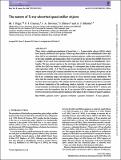Por favor, use este identificador para citar o enlazar a este item:
http://hdl.handle.net/10261/46827COMPARTIR / EXPORTAR:
 SHARE
BASE SHARE
BASE
|
|
| Visualizar otros formatos: MARC | Dublin Core | RDF | ORE | MODS | METS | DIDL | DATACITE | |

| Título: | The nature of X-ray-absorbed quasi-stellar objects |
Autor: | Page, Matt; Carrera, Francisco J. CSIC ORCID CVN ; Stevens, J. A.; Ebrero, Jacobo CSIC ORCID; Blustin, A. J. | Palabras clave: | Galaxies: active Galaxies: evolution Galaxies: formation X-ray galaxies |
Fecha de publicación: | oct-2011 | Editor: | Oxford University Press | Citación: | Monthly Notices of the Royal Astronomical Society 416(4): 2792-2801 (2011) | Resumen: | There exists a significant population of broad line, z∼ 2 quasi-stellar objects (QSOs) which have heavily absorbed X-ray spectra. Follow-up observations in the submillimetre show that these QSOs are embedded in ultraluminous starburst galaxies, unlike most unabsorbed QSOs at the same redshifts and luminosities. Here we present X-ray spectra from XMM–Newton for a sample of five such X-ray-absorbed QSOs that have been detected at submillimetre wavelengths. We also present spectra in the rest-frame ultraviolet from ground-based telescopes. All the five QSOs are found to exhibit strong C iv absorption lines in their ultraviolet spectra with equivalent width >5 Å. The X-ray spectra are inconsistent with the hypothesis that these objects show normal QSO continua absorbed by low-ionization gas. Instead, the spectra can be modelled successfully with ionized absorbers, or with cold absorbers if they possess unusually flat X-ray continuum shapes and unusual optical to X-ray spectral energy distributions. We show that the ionized absorber model provides the simplest, most self-consistent explanation for their observed properties. We estimate that the fraction of radiated power that is converted into kinetic luminosity of the outflowing winds is typically ∼4 per cent, in agreement with recent estimates for the kinetic feedback from QSOs required to produce the M–σ relation, and consistent with the hypothesis that the X-ray-absorbed QSOs represent the transition phase between obscured accretion and the luminous QSO phase in the evolution of massive galaxies. | Versión del editor: | http://dx.doi.org/10.1111/j.1365-2966.2011.19226.x | URI: | http://hdl.handle.net/10261/46827 | ISSN: | 0035-8711 | E-ISSN: | 1365-2966 |
| Aparece en las colecciones: | (IFCA) Artículos |
Ficheros en este ítem:
| Fichero | Descripción | Tamaño | Formato | |
|---|---|---|---|---|
| naturobje.pdf | 887,6 kB | Adobe PDF |  Visualizar/Abrir |
CORE Recommender
Page view(s)
318
checked on 23-abr-2024
Download(s)
215
checked on 23-abr-2024
Google ScholarTM
Check
NOTA: Los ítems de Digital.CSIC están protegidos por copyright, con todos los derechos reservados, a menos que se indique lo contrario.
